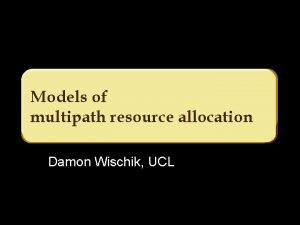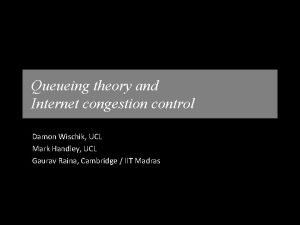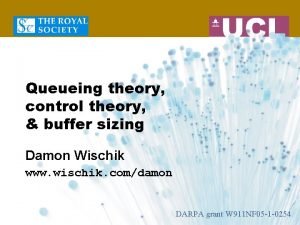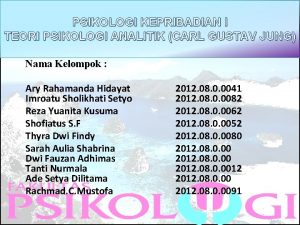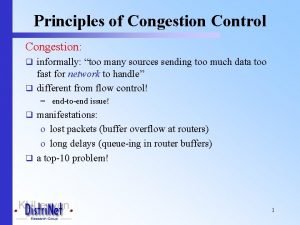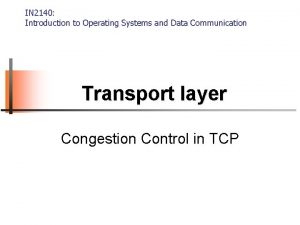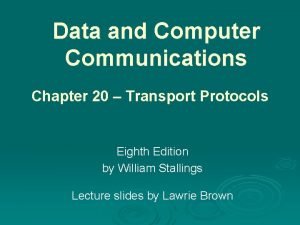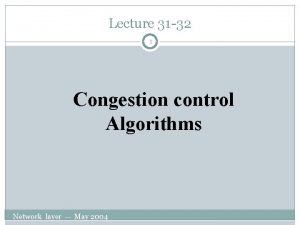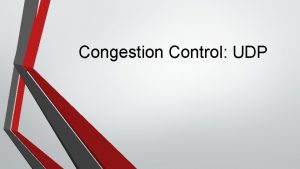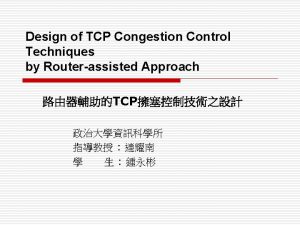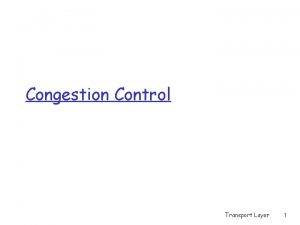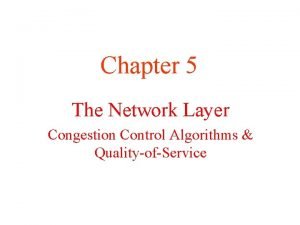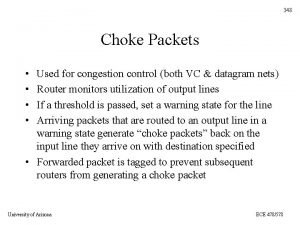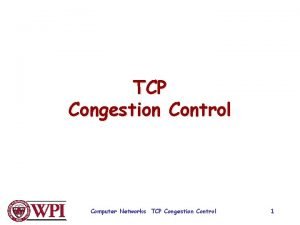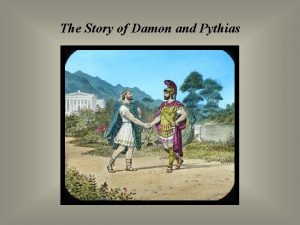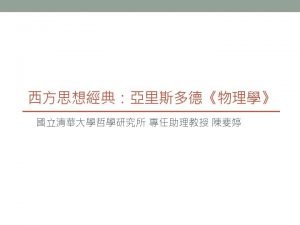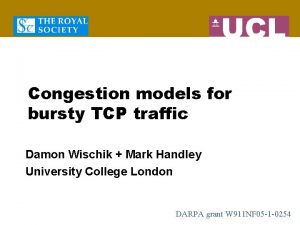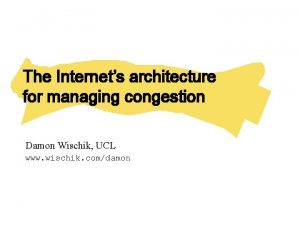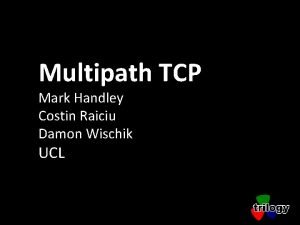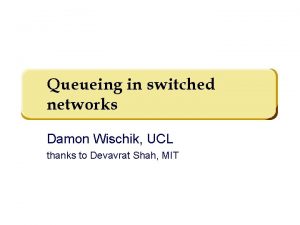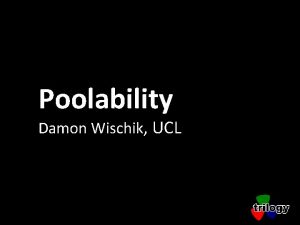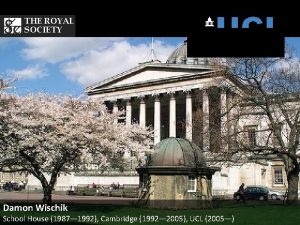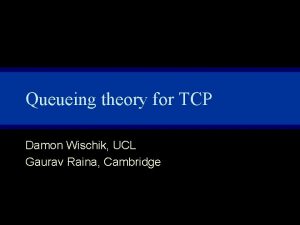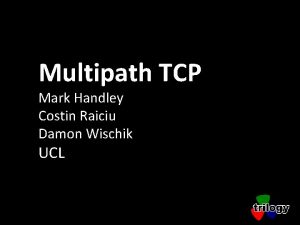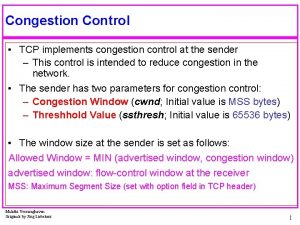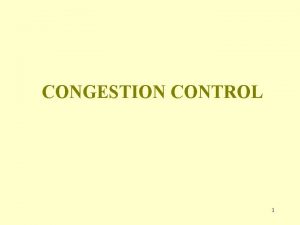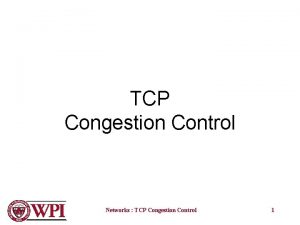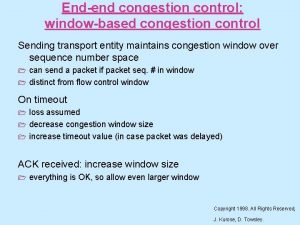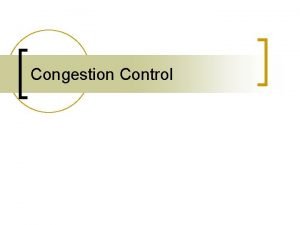The teleology of Internet congestion control Damon Wischik







![transmission rate [0– 100 k. B/sec] time [0– 8 sec] if (seqno > _last_acked) transmission rate [0– 100 k. B/sec] time [0– 8 sec] if (seqno > _last_acked)](https://slidetodoc.com/presentation_image_h2/5ee49b9ba78fe616f512d1dad20c92d3/image-8.jpg)
















- Slides: 24

The teleology of Internet congestion control Damon Wischik, Computer Science, UCL

What network am I looking at? There is the physical network, that describes which computers and switches are connected by which links. There is the logical network, that describes which users are using which paths through the network. This talk is about traffic flows. Each traffic flow belongs to some user, and is carried over some collection of computers and switches. One user's traffic flow influences other users' flows indirectly, by virtue of the links they use in common.

teleology from the Greek τελος (end) + -λογια (discourse, study) The doctrine or study of ends or final causes, especially as related to the evidences of design or purpose in nature; also transf. such design as exhibited in natural objects or phenomena.

The history of the Internet • 1974: First draft of TCP/IP “A protocol for packet network interconnection”, Vint Cerf and Robert Kahn • 1983: ARPANET switches on TCP/IP • 1986: Congestion collapse

“In October of ’ 86, the Internet had the first of what became a series of ‘congestion collapses’. During this period, the data throughput from LBL to UC Berkeley (sites separated by 400 yards and two IMP hops) dropped from 32 Kbps to 40 bps. We were fascinated by this sudden factor-of-thousand drop in bandwidth and embarked on an investigation of why things had gotten so bad. ” Van Jacobson, “Congestion avoidance and control”, 1988

The history of the Internet • 1974: First draft of TCP/IP “A protocol for packet network interconnection”, Vint Cerf and Robert Kahn • 1983: ARPANET switches on TCP/IP • 1986: Congestion collapse • 1988: Congestion control for TCP “Congestion avoidance and control”, Van Jacobson and not much has happened since (apart from the web, Google, e. Bay, Facebook, Bit. Torrent, …)

Jacobson’s big idea * * * * Each user should increase his/her transmission rate when the network seems underused, and cut it when one of his/her packets is dropped (which signifies congestion). * ** * * * If all users do this, the network ends up near-100% used, and the capacity is shared fairly.
![transmission rate 0 100 k Bsec time 0 8 sec if seqno lastacked transmission rate [0– 100 k. B/sec] time [0– 8 sec] if (seqno > _last_acked)](https://slidetodoc.com/presentation_image_h2/5ee49b9ba78fe616f512d1dad20c92d3/image-8.jpg)
transmission rate [0– 100 k. B/sec] time [0– 8 sec] if (seqno > _last_acked) { if (!_in_fast_recovery) { _last_acked = seqno; _dupacks = 0; inflate_window(); send_packets(now); _last_sent_time = now; return; } if (seqno < _recover) { uint 32_t new_data = seqno - _last_acked; _last_acked = seqno; if (new_data < _cwnd) _cwnd -= new_data; else _cwnd=0; _cwnd += _mss; retransmit_packet(now); send_packets(now); return; } uint 32_t flightsize = _highest_sent - seqno; _cwnd = min(_ssthresh, flightsize + _mss); _last_acked = seqno; _dupacks = 0; _in_fast_recovery = false; send_packets(now); return; } if (_in_fast_recovery) { _cwnd += _mss; send_packets(now); return; } _dupacks++; if (_dupacks!=3) { send_packets(now); return; } _ssthresh = max(_cwnd/2, (uint 32_t)(2 * _mss)); retransmit_packet(now); _cwnd = _ssthresh + 3 * _mss; _in_fast_recovery = true; _recover = _highest_sent; }

Jacobson’s big idea was that congestion could be controlled by relying on users to respond sensibly.

The big telecoms companies did not believe him. (They still don’t want to. ) Why should they?

We know the microscopic rules of behaviour of the Internet, i. e. the code. if (seqno > _last_acked) { if (!_in_fast_recovery) { _last_acked = seqno; _dupacks = 0; inflate_window(); send_packets(now); _last_sent_time = now; return; } if (seqno < _recover) { uint 32_t new_data = seqno - _last_acked; _last_acked = seqno; if (new_data < _cwnd) _cwnd -= new_data; else _cwnd=0; _cwnd += _mss; retransmit_packet(now); send_packets(now); return; } uint 32_t flightsize = _highest_sent - seqno; _cwnd = min(_ssthresh, flightsize + _mss); _last_acked = seqno; _dupacks = 0; _in_fast_recovery = false; send_packets(now); return; } if (_in_fast_recovery) { _cwnd += _mss; send_packets(now); return; } _dupacks++; if (_dupacks!=3) { send_packets(now); return; } _ssthresh = max(_cwnd/2, (uint 32_t)(2 * _mss)); retransmit_packet(now); _cwnd = _ssthresh + 3 * _mss; _in_fast_recovery = true; _recover = _highest_sent; } We can derive macroscopic formulae which tell us about the average behaviour of each component. But how does the whole behave?

Theorem (Kelly et al. 1998, Towsley et al. 2000) The Internet shares capacity as if there were an intelligent designer+controller who seeks to maximize the sum total of every user’s happiness with his/her lot, subject to available capacity on each link.

The Internet's algorithms behave as if the network as a whole were trying to solve an optimization problem. I call this emergent teleology.

Theorem (Kelly et al. 1998, Towsley et al. 2000)

Your implied utility function

Research agenda Microscopic rules of behaviour, specified by the code if (seqno > _last_acked) { if (!_in_fast_recovery) { _last_acked = seqno; _dupacks = 0; inflate_window(); send_packets(now); _last_sent_time = now; return; } if (seqno < _recover) { uint 32_t new_data = seqno - _last_acked; _last_acked = seqno; if (new_data < _cwnd) _cwnd -= new_data; else _cwnd=0; _cwnd += _mss; retransmit_packet(now); send_packets(now); return; } uint 32_t flightsize = _highest_sent - seqno; _cwnd = min(_ssthresh, flightsize + _mss); _last_acked = seqno; _dupacks = 0; _in_fast_recovery = false; send_packets(now); return; } if (_in_fast_recovery) { _cwnd += _mss; send_packets(now); return; } _dupacks++; if (_dupacks!=3) { send_packets(now); return; } _ssthresh = max(_cwnd/2, (uint 32_t)(2 * _mss)); retransmit_packet(now); _cwnd = _ssthresh + 3 * _mss; _in_fast_recovery = true; _recover = _highest_sent; } Macroscopic formulae for average behaviour of a component Teleological descriptions of how the whole behaves

form + function topology + algorithms There has been much work on the structure of complex networks (scale free topologies etc. ) In Internet architecture, we are more interested in how algorithms function over the network. We treat the topology as a given, and we seek robust algorithms that work well with any topology or traffic pattern. There is one area where the two fields overlap…

Where topology and algorithms overlap: We conjecture that if users have sufficiently diverse paths, and they balance their traffic appropriately, then the Internet will achieve resource pooling, i. e. it will behave as if there were a single giant link, fairly shared between all users.




“I want to book a train to Aberdeen. There’s spare capacity on the train to Bristol. Therefore my booking will be accepted. ”

Formally speaking, we believe that multipath congestion control will change the constraint in the teleology.

Engineering agenda Invent microscopic code that yields this macroscopic behaviour Work out macroscopic formulae for the average behaviour of a component Decide on the teleology that we want if (seqno > _last_acked) { if (!_in_fast_recovery) { _last_acked = seqno; _dupacks = 0; inflate_window(); send_packets(now); _last_sent_time = now; return; } if (seqno < _recover) { uint 32_t new_data = seqno - _last_acked; _last_acked = seqno; if (new_data < _cwnd) _cwnd -= new_data; else _cwnd=0; _cwnd += _mss; retransmit_packet(now); send_packets(now); return; } uint 32_t flightsize = _highest_sent - seqno; _cwnd = min(_ssthresh, flightsize + _mss); _last_acked = seqno; _dupacks = 0; _in_fast_recovery = false; send_packets(now); return; } if (_in_fast_recovery) { _cwnd += _mss; send_packets(now); return; } _dupacks++; if (_dupacks!=3) { send_packets(now); return; } _ssthresh = max(_cwnd/2, (uint 32_t)(2 * _mss)); retransmit_packet(now); _cwnd = _ssthresh + 3 * _mss; _in_fast_recovery = true; _recover = _highest_sent; } (We don't want network topology to be a constraint, only total network capacity. )
 Damon wischik
Damon wischik Damon wischik
Damon wischik Damon wischik
Damon wischik Wischik
Wischik Circumciliary congestion and conjunctival congestion
Circumciliary congestion and conjunctival congestion Psikologi analitik jung
Psikologi analitik jung Teleology in nursing
Teleology in nursing Kant’s categorical imperative
Kant’s categorical imperative Principles of congestion control
Principles of congestion control Tcp congestion control
Tcp congestion control Tcp congestion control
Tcp congestion control Network provisioning in congestion control
Network provisioning in congestion control Principles of congestion control
Principles of congestion control General principles of congestion control
General principles of congestion control Congestion control in virtual circuit
Congestion control in virtual circuit Udp congestion control
Udp congestion control New reno tcp
New reno tcp Principles of congestion control
Principles of congestion control Congestion control in network layer
Congestion control in network layer What is choke packet
What is choke packet Segment header
Segment header General principles of congestion control
General principles of congestion control Lucian wischik
Lucian wischik Damon burton
Damon burton Damon and pythias friendship
Damon and pythias friendship
